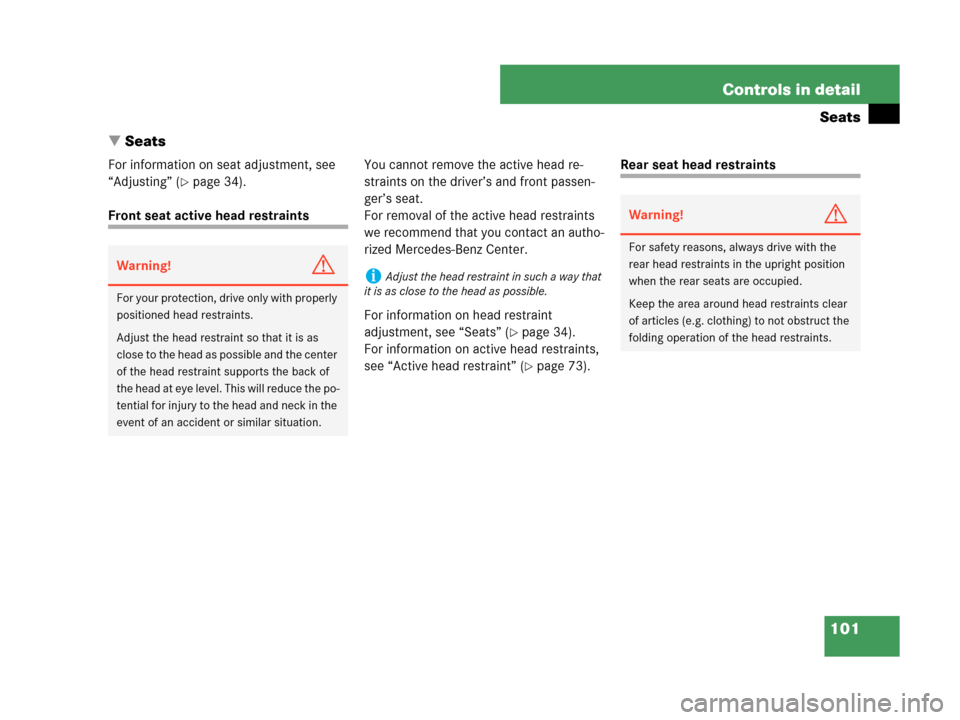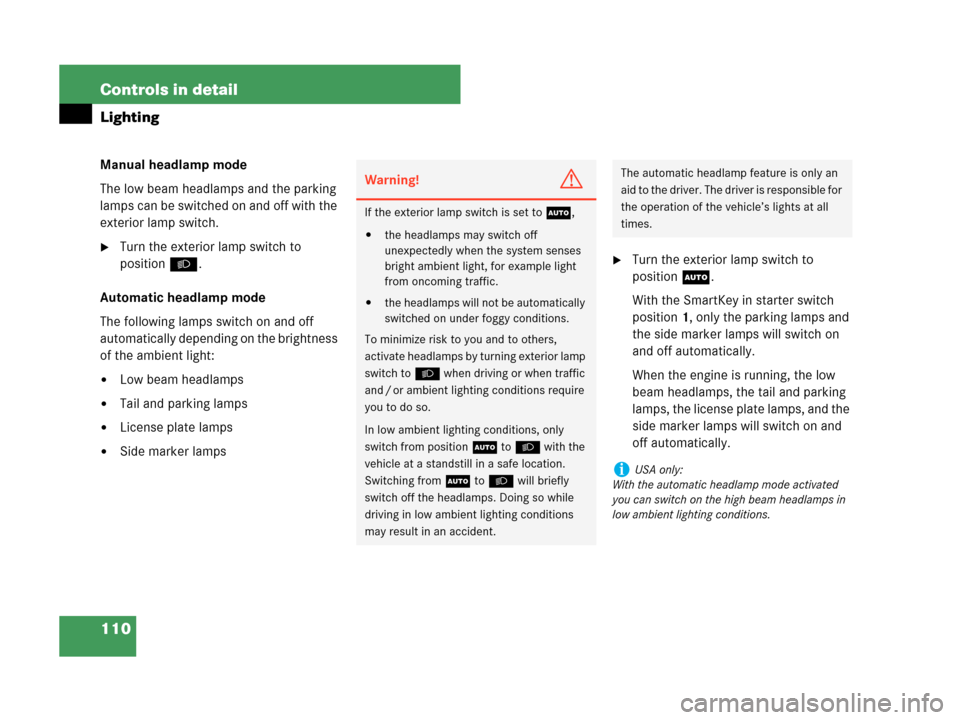Page 101 of 441

100 Controls in detail
Locking and unlocking
Locking and unlocking from the inside
You can lock or unlock the doors and the
trunk from inside using the central locking
or unlocking switch. This can be useful, for
example, if you want to lock the vehicle
before starting to drive.
You cannot lock or unlock the fuel filler flap
with the central locking or unlocking
switch.The switches are located in the center
console.
1Central locking switch
2Central unlocking switchLocking
�Press central locking switch1.
If all doors are closed, the vehicle
locks.
Unlocking
�Press central unlocking switch2.
The vehicle unlocks.
Warning!G
When leaving the vehicle, always remove the
SmartKey from the starter switch, take it
with you, and lock the vehicle. Do not leave
children unattended in the vehicle, or with
access to an unlocked vehicle. A child’s
unsupervised access to a vehicle could
result in an accident and/or serious
personal injury.
iYou can open a locked door from the inside.
Open door only when conditions are safe to do
so.
If the vehicle was previously centrally locked us-
ing the SmartKey, it will not unlock using the cen-
tral unlocking switch2.
If the vehicle was previously locked with the cen-
tral locking switch1
�while in the selective remote control mode,
only the door opened from the inside is un-
locked.
�while in the global remote control mode, the
complete vehicle is unlocked when a door is
opened from the inside.
Page 102 of 441

101 Controls in detail
Seats
�Seats
For information on seat adjustment, see
“Adjusting” (
�page 34).
Front seat active head restraintsYou cannot remove the active head re-
straints on the driver’s and front passen-
ger’s seat.
For removal of the active head restraints
we recommend that you contact an autho-
rized Mercedes-Benz Center.
For information on head restraint
adjustment, see “Seats” (
�page 34).
For information on active head restraints,
see “Active head restraint” (
�page 73).
Rear seat head restraints
Warning!G
For your protection, drive only with properly
positioned head restraints.
Adjust the head restraint so that it is as
close to the head as possible and the center
of the head restraint supports the back of
the head at eye level. This will reduce the po-
tential for injury to the head and neck in the
event of an accident or similar situation.
iAdjust the head restraint in such a way that
it is as close to the head as possible.
Warning!G
For safety reasons, always drive with the
rear head restraints in the upright position
when the rear seats are occupied.
Keep the area around head restraints clear
of articles (e.g. clothing) to not obstruct the
folding operation of the head restraints.
Page 103 of 441

102 Controls in detail
Seats
Head restraint height (rear outer seats)
1Release buttonRaising
�Manually adjust the height of the head
restraint by pulling it upward.
If the head restraint is fully retracted,
push release button1 and pull the
head restraint up.
Lowering
�To lower the head restraint, push
release button1 and push down on
the head restraint.Folding head restraints back with
release button
The rear seat head restraints can be folded
backward for increased visibility.
1Release button
�Push release button1.
The head restraint will fold backward.
Warning!G
For your protection, drive only with properly
positioned head restraints.
Adjust head restraint so that the head re-
straint supports the back of the head at eye
level. This will reduce the potential for injury
to the head and neck in the event of an ac-
cident or similar situation.
Do not drive the vehicle without the seat
head restraints. Head restraints are
intended to help reduce injuries during an
accident.
iAdjust the head restraint in such a way that
it is as close to the head as possible.
iYou can also fold the rear outer seat head
restraints back using the switch in the center
console.
Page 104 of 441
103 Controls in detail
Seats
Folding head restraints back with
switch in the center console
1Switch for rear seat head restraints
�Start the engine (�page 46).
�Press switch1.
The rear seat head restraints will fold
backward.Placing head restraints upright
�Pull the head restraint forward until it
locks into position.Head restraint tilt (rear outer seats)
Two different head restraint angle
positions are available:
�Press the release button (�page 102)
and tilt the head restraint to the
desired position.
Warning!G
Make sure the head restraints engage when
placing them upright. Otherwise their
protective function cannot be assured.
iAdjust the head restraint in such a way that
it is as close to the head as possible.
Page 105 of 441

104 Controls in detail
Seats
Removing and installing rear seat head
restraints (rear outer seats)
1Release button
Removing rear seat head restraints
�Fold back head restraint (�page 102).
�Pull head restraint to its highest
position.
�Push release button1 and pull out
head restraint.Installing rear seat head restraints
�Insert head restraint and push it down
until it engages.
�Push release button1 and adjust
head restraint to desired position.
iThe rear center seat head restraint cannot
be removed.
Warning!G
For your protection, drive only with properly
positioned head restraints.
Adjust head restraint so that the head re-
straint supports the back of the head at eye
level. This will reduce the potential for injury
to the head and neck in the event of an ac-
cident or similar situation.
Do not drive the vehicle without the seat
head restraints. Head restraints are intend-
ed to help reduce injuries during an acci-
dent.
Do not interchange head restraints from
front and rear seat.
iAdjust the head restraint in such a way that
it is as close to the head as possible.
Page 108 of 441

107 Controls in detail
Memory function*
�Memory function*
Prior to operating the vehicle, the driver
should check and adjust the seat height,
seat position fore and aft, and seat back-
rest angle if necessary, to ensure adequate
control, reach and comfort. The head re-
straint should also be adjusted for proper
height. See also the section on air bags
(
�page 59) for proper seat positioning.
In addition, adjust the steering wheel to
ensure adequate control, reach, operation
and comfort. Both the interior and exterior
rear view mirrors should be adjusted for
adequate rear vision.
Fasten seat belts. Infants and small chil-
dren should be seated in a properly se-
cured restraint system that complies with
U.S. Federal Motor Vehicle Safety
Standards 213 and 225 and
Canadian Motor Vehicle Safety Standards
213 and 210.2.With the memory function you can store up
to three different settings.
The following settings are stored for the
driver’s seat when using the buttons on the
driver’s door:
�Driver’s seat, backrest and head
restraint position
�Steering wheel position
�Exterior rear view mirrorsThe following settings are stored for the
front passenger seat when using the but-
tons (if so equipped depending on vehicle
equipment configuration) on the passen-
ger door:
�Front passenger seat, backrest and
head restraint position
Warning!G
Do not activate the memory function while
driving. Activating the memory function
while driving could cause the driver to lose
control of the vehicle.
Page 110 of 441

109 Controls in detail
Lighting
�Lighting
For information on how to switch on the
headlamps and use the turn signals, see
“Switching on headlamps” (
�page 50)
and “Turn signals” (
�page 50).
Exterior lamp switch
Exterior lamp switch
MOff
Daytime running lamp mode
(
�page 111)
UAutomatic headlamp mode
Daytime running lamp mode
(
�page 111)
CParking lamps (also tail lamps,
license plate lamps, side marker
lamps, instrument panel lamps)BLow beam headlamps or high beam
headlamps when the combination
switch is pushed forward. The tail
lamps, license plate lamps, side
marker lamps, parking lamps and
instrument panel lamps also come
on.
ˆStanding lamps, right (turn left one
stop)
‚Standing lamps, left (turn left two
stops)
‡Indicator lamp for front fog lamps
†Indicator lamp for rear fog lamp
iIf you drive in countries where vehicles drive
on the other side of the road than the country
where the vehicle is registered, you must have
the headlamps modified for symmetrical low
beams. Relevant information can be obtained at
your authorized Mercedes-Benz Center.
iIf you hear a warning signal you have
forgotten to switch off the headlamps before
opening the driver’s door.
In addition the message
Switch off lights
appears in the multifunction display.
Switch off the headlamps.
Page 111 of 441

110 Controls in detail
Lighting
Manual headlamp mode
The low beam headlamps and the parking
lamps can be switched on and off with the
exterior lamp switch.
�Turn the exterior lamp switch to
positionB.
Automatic headlamp mode
The following lamps switch on and off
automatically depending on the brightness
of the ambient light:
�Low beam headlamps
�Tail and parking lamps
�License plate lamps
�Side marker lamps
�Turn the exterior lamp switch to
positionU.
With the SmartKey in starter switch
position1, only the parking lamps and
the side marker lamps will switch on
and off automatically.
When the engine is running, the low
beam headlamps, the tail and parking
lamps, the license plate lamps, and the
side marker lamps will switch on and
off automatically.
Warning!G
If the exterior lamp switch is set toU,
�the headlamps may switch off
unexpectedly when the system senses
bright ambient light, for example light
from oncoming traffic.
�the headlamps will not be automatically
switched on under foggy conditions.
To minimize risk to you and to others,
activate headlamps by turning exterior lamp
switch toB when driving or when traffic
and / or ambient lighting conditions require
you to do so.
In low ambient lighting conditions, only
switch from positionU toB with the
vehicle at a standstill in a safe location.
Switching fromU toB will briefly
switch off the headlamps. Doing so while
driving in low ambient lighting conditions
may result in an accident.
The automatic headlamp feature is only an
aid to the driver. The driver is responsible for
the operation of the vehicle’s lights at all
times.
iUSA only:
With the automatic headlamp mode activated
you can switch on the high beam headlamps in
low ambient lighting conditions.